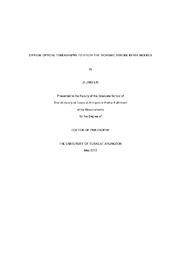
ATTENTION: The works hosted here are being migrated to a new repository that will consolidate resources, improve discoverability, and better show UTA's research impact on the global community. We will update authors as the migration progresses. Please see MavMatrix for more information.
Show simple item record
| dc.contributor.author | Lin, Zi-Jing | |
| dc.date.accessioned | 2016-01-28T18:03:46Z | |
| dc.date.available | 2016-01-28T18:03:46Z | |
| dc.date.issued | 05-06-2013 | |
| dc.date.submitted | January 2013 | |
| dc.identifier.other | DISS-12211 | |
| dc.identifier.uri | http://hdl.handle.net/10106/25545 | |
| dc.description.abstract | Stroke, including ischemic stroke and hemorrhagic stroke, is the major leading cause of death in the United States. More than 80 percent of stroke patients are diagnosed with ischemic stroke, which usually results from blockage of artery in the brain by thrombosis or arterial embolism. Animal Models, which permit powerful genetic and molecular approaches, provide an essential tool to study and understand the basic processes and potential therapeutic interventions for this disease. Significant efforts have been made to closely mimic the changes that occur in humans during and after stroke using animal models. Recent development on near infrared (NIR) diffuse optical tomography (DOT) has been made to non-invasively image the changes of hemoglobin concentrations in human and animal brains. DOT is an attractive approach for evaluating and investigating stroke physiology. It can provide hemodynamic images of animal stroke with a potential for continuous, non-invasive monitoring at different stages of ischemic stroke. My research focuses on examining continuous wave (CW) DOT to study cerebral ischemia in rat models. This work consists two main parts. In the first part, a CCD-camera-based DOT system was built for animal measurements. The system was calibrated and validated by computer simulations as well as by the laboratory tissue-like phantoms. The recently developed depth compensation algorithm was introduced to help the depth localization and image quality in three dimensional diffuse optical image reconstructions. Another image reconstruction method, globally convergent method developed by a group of our collaborators, was briefly introduced. Laboratory phantom measurements showed the ability of CCD-camera-based DOT to image small perturbation in tissue-mimic phantoms, demonstrating that the system has a great potential to image heterogeneity in biological tissues, such as ischemic stroke in the rat brain. However, this CCD-camera-based DOT failed to produce good-quality images when being used in actual rat ischemic stroke models; this failure may result from the non-contact CCD-camera approach, which is more sensitive or weighted toward surface reflection signals with a smaller portion of diffuse light detected.In the second part of my work, a fiber-based CW DOT system was alternatively utilized to investigate two commonly-used rat ischemic stroke models, suture and embolism models. Volumetric images of changes in oxy-hemoglobin concentration due to ischemic stroke were successfully reconstructed, with improved spatial resolution, using a rat brain atlas. Also, quantification of changes in cerebral blood flow (CBF) during and after cerebral ischemia is crucial because ischemic tissues may be recovered or dead depending on different levels of blood perfusion. Since CW DOT measures only changes of hemoglobin concentrations, an Indocyanine green (ICG) tracking technique was introduced to determine corresponding CBF. Results from the two rat stroke models show that with an interleaved approach, changes of hemoglobin concentrations and of CBF, during as well as after stroke, can be simultaneously determined using the fiber-based DOT system. In this way, I was able to show and identify therapeutic outcomes of a thrombolytic treatment given to the embolism-induced ischemic model. Furthermore, resting-state functional connectivity (RSFC) was also investigated to reveal lesion-induced neuronal connection disruption during stroke and tissue recovery after stroke. Final analysis shows loss of bilateral RSFC after cerebral ischemia, followed by partial RSFC recovery during the reperfusion phase. | |
| dc.description.sponsorship | Liu, Hanli | |
| dc.language.iso | en | |
| dc.publisher | Biomedical Engineering | |
| dc.title | Diffuse Optical Tomography To Study The Ischemic Stroke In Rat Models | |
| dc.type | Ph.D. | |
| dc.contributor.committeeChair | Liu, Hanli | |
| dc.degree.department | Biomedical Engineering | |
| dc.degree.discipline | Biomedical Engineering | |
| dc.degree.grantor | University of Texas at Arlington | |
| dc.degree.level | doctoral | |
| dc.degree.name | Ph.D. | |
Files in this item
- Name:
- Lin_uta_2502D_12211.pdf
- Size:
- 17.25Mb
- Format:
- PDF
This item appears in the following Collection(s)
Show simple item record


